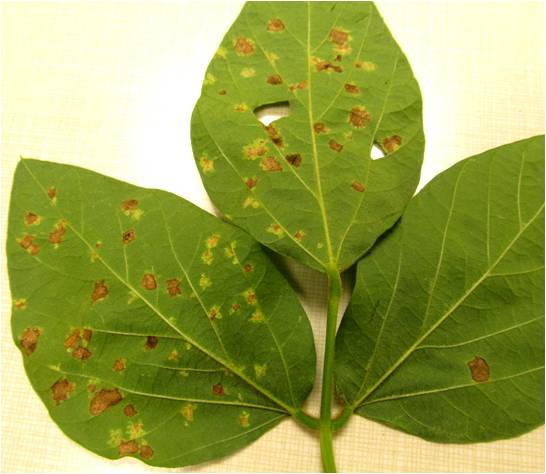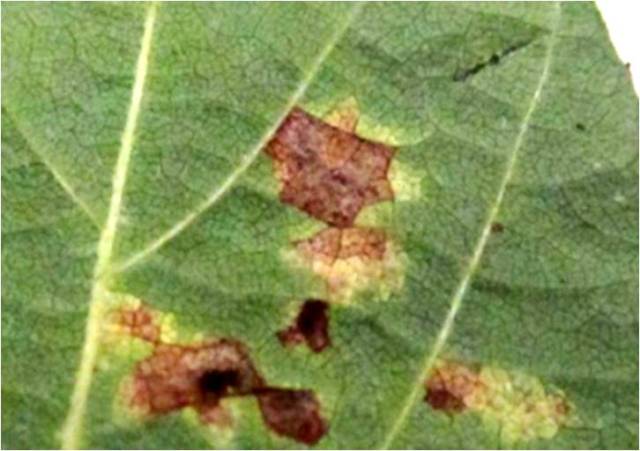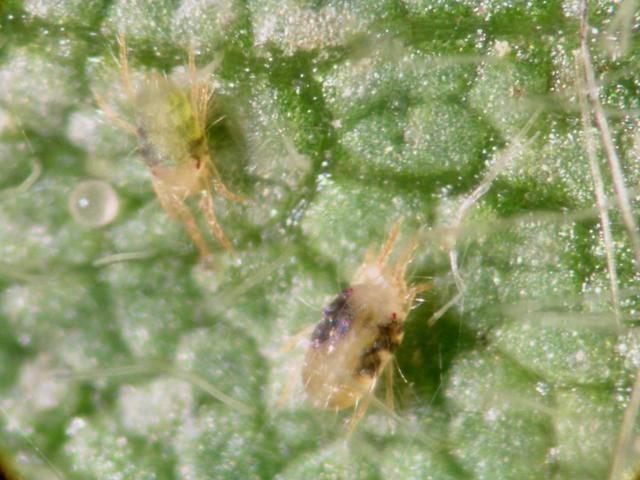Manitoba Insect & Disease Update: August 22, 2014
Compiled by:
- John Gavloski, Entomologist
Manitoba Agriculture, Food and Rural Development
Phone: (204) 745-5668
Fax: (204) 745-5690. - Vikram Bisht, Plant Pathologist
Manitoba Agriculture, Food and Rural Development
Phone: (204) 745-0260
Fax: (204) 745-5690
To report observations on insects or plant pathogens that may be of interest or importance to farmers and agronomists in Manitoba, please send messages to the above contact address.
To be placed on an E-mail list so you will be notified immediately when new Manitoba Insect and Disease Updates are posted, please contact John Gavloski at the address or numbers listed above.
To be placed on an E-mail list so you will be notified immediately when new Manitoba Insect and Disease Updates are posted, please contact John Gavloski at the address or numbers listed above.
Summary
With warm conditions continuing and with rainfall deficit in many area of Manitoba, many crops are showing effects, such as poor growth on corn, sunflowers and soybeans. Plants are stunted and foliage is desiccating and leaf drop has been seen in soybeans. Diseases favoured by high humidity appear to have stopped in their tracks; but plants with root rots will now start showing up. Scattered heavy showers in parts of Manitoba may have provided some respite.
Some spider mites have been showing up along the edges of some soybean fields. Lygus bugs levels have been high in some canola fields, although many fields are now beyond the stage where Lygus bugs can be of concern. If there is brown-green mottling in the seeds in the lower pods, or complete colour change, than the crop will no longer be at risk of injury from Lygus bugs.
Canola
The Canola disease survey in now on-going for blackleg, root rots, white mold, aster yellows and alternaria pod blight. Due to changing strains of the blackleg fungus, some of the R rated varieties may show higher levels of blackleg in different regions.
Soybeans
Diseases: Mid-May planted fields have in general reached the R6 stage, i.e. full green seed formation in the pod. Many fields need water, indicated by top pods aborting and lower leaves with yellowing not caused by brown spot disease.
The diseases most commonly seen are brown spot, bacterial blight, downy mildew, and scattered plants of Phytophthora root rot (mostly 1-2%). In some fields, especially soybean following soybean, there is apparently a higher number of downy mildew leaf spots, many of which have matured into a brown color, but are still showing downy growth on the underside of the leaves (Fig 1a – 1c).
Heavy scattered rains with strong winds have lodged a few fields of lush soybeans, and could create a micro-climate favourable for white mold development.
At this stage of crop development, none of these diseases or the level of severity would benefit from a fungicide spray.
The diseases most commonly seen are brown spot, bacterial blight, downy mildew, and scattered plants of Phytophthora root rot (mostly 1-2%). In some fields, especially soybean following soybean, there is apparently a higher number of downy mildew leaf spots, many of which have matured into a brown color, but are still showing downy growth on the underside of the leaves (Fig 1a – 1c).
Heavy scattered rains with strong winds have lodged a few fields of lush soybeans, and could create a micro-climate favourable for white mold development.
At this stage of crop development, none of these diseases or the level of severity would benefit from a fungicide spray.

Fig. 1a. Typical lemon-yellow spots of downy mildew on soybean. Photo: Vikram Bisht, MAFRD.

Fig. 1b. As the downy mildew spots spots mature, many turn brown. Photo: Vikram Bisht, MAFRD.

Fig. 1c. Close up of mature downy mildew spots, showing the fungal sporulation on the underside of leaf. Photo: Vikram Bisht, MAFRD
Spider mites – In a few soybean fields, feeding from spider mites and yellowing of leaves has been noticed, mainly around the edges of the field. There is often a strong edge effect with spider mites on soybeans.
Spider mite populations are often higher when conditions have been hot and dry for a sustained period of time, and populations can change substantially after heavy rains. So if you have been noticing what appears to be feeding from spider mites on soybean plants, and the area has had some recent rain, make sure to look for the mites and see what the current population is like. Spider mites are small (about 0.4 mm), so tapping the leaves over something that the mites can easily be seen on may help in determining their presence and levels.
The stages of soybeans that are most susceptible to spider mites are the R4 (full pod) through R5 (beginning seed – when seeds are filling) stages. Once the soybeans reach R6 (full seed or green bean stage) the feeding from spider mites will have less impact on yield.

Fig. 2. Two-spotted spider mites on soybeans.
Soybean Aphids. Low levels of soybean aphids have been showing up in more fields in southern Manitoba over the past week, but so far no fields have been reported with economical populations of aphids. Given the current stage of the soybean crop, late arrival of the aphids and current population, it is not likely we will see economical populations of soybean aphids this year. However, it is good to be monitoring levels, particularly in later seeded fields. A reminder that the economic threshold for soybean aphids is when there are on average at least 250 aphids per plant, and the population is increasing, and the plants are in the R1 to R5 growth stages. See last weeks update for a more detailed discussion on the economic threshold for soybean aphid.
Wheat
Up to 15-25% of spikes/heads are being recorded with Fusarium head blight infection in winter wheat. This year ergot bodies can be seen in rye, barley, wheat and some grassy weeds.
Flax
Potato aphid in flax – There have been a couple of recent reports regarding aphids in flax, although it is getting late for aphids to be of economical importance in flax.
The economic threshold for aphids in flax is about 3 aphids per main stem on average at full bloom, and 8 aphids per main stem on average at the green boll stage. Yield loss caused by potato aphids in flax is about 0.33 bu/acre per aphid per plant for crops sampled at full bloom, and 0.13 bu/acre per aphid per plant for crops sampled at the green boll stage.
The other thing that needs to be considered though is that potato aphids emigrate out of flax in mid-August, regardless of crop stage, population density of the aphids, and average temperature at the time of the photoperiodic cue. This emigration assures aphids have time to develop, mate, and lay eggs on their overwintering hosts before temperatures drop. The publication reporting on this emigration behaviour from flax states “farmers need not sample or control potato aphids in flax after mid-August” (The Canadian Entomologist. 1997: 1049-1058). Potato aphids overwinter on plants in the rose family, particularly wild roses.
